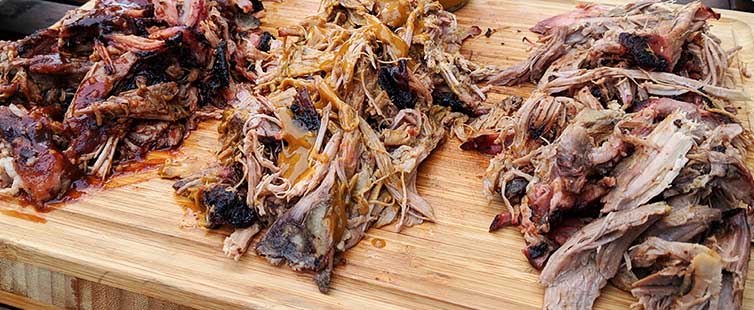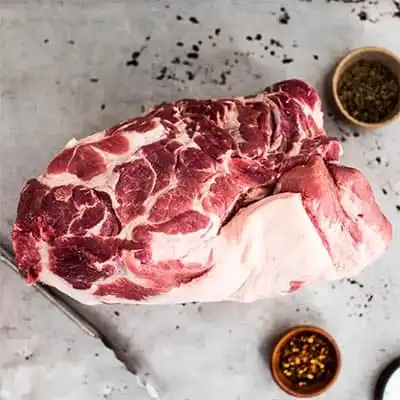What’s the Difference Between Pork Butt and Pork Shoulder?

Whoever is in charge of naming meat cuts must love to confuse people.
There’s no other reason why you would call something pork butt even though it isn’t from the rear of the pig, or pork shoulder when it is only part of the shoulder.
These two cuts of pork are often mixed up so we’ve put together this guide to explain exactly what the difference between pork butt and pork shoulder is.
Pork butt vs pork shoulder – what’s the difference?
Before we can talk about the differences between pork butt and pork shoulder, we’ve got to understand from where on the pig they’re cut.

When initially breaking down a carcass, butchers first cut the muscles into large portions called primal cuts. Each front shoulder is broken down as one primal cut from the pig.
Once separated, the primal shoulder is then split into two sub-primal cuts: pork butt and pork shoulder.
The pork butt is located directly behind a pig’s head and lies above the pig’s shoulder blade, and though referred to as a butt, it does not come from the hindquarters of the animal, but rather the front.
The shoulder or picnic shoulder as it’s sometimes called is located directly below the butt on the leg of the pig and runs down to just above the pig’s front hoof, or hock.
| Pork Butt | Pork Shoulder | |
| Common names | Boston butt | Picnic shoulder, Picnic roast |
| Characteristics | Marbled with lots of intramuscular fat | Less fat and can be tough unless cooked properly |
| Shape | Even rectangular shape | Triangular shaped |
| Best for | Pulled pork | Pork roast with crackling |
So pork butt and pork shoulder both come from the front leg of the animal, and though they’re from the same area, the consistency of each piece varies slightly such as the amount of fat marbling and the toughness of the meat .
Knowing the differences between each cut will not only make your trip to the butcher easier, but you’ll know which cut is better for what recipes as well.
Pork butt (Boston butt) explained

As mentioned, the pork butt sits on top of the pig’s shoulder blade directly behind its head.
This cut – also referred to as a Boston Butt – is very well marbled with quality intramuscular fat due to the fact that it’s not an overly utilized muscle on the animal.
This lends itself to a flavorful, tender piece of meat in comparison to the pork shoulder sub-primal.
Pork butt is usually sold with the shoulder blade bone still in and fat cap on one side. As is, this piece of meat is perfect for low and slow cooking such as smoking or braising.
The end result of low and slow cooking renders the internal fat, making for juicy, flavorful pulled pork.
Though low and slow may be the popular method, it is not the only way to prepare a pork butt.
You can go boneless and then cut the butt into pork steaks for grilling, or to make pork butt burnt ends, or shaved thin for stir fry.

The sub-primal pork butt has a perfect meat-to-fat ratio for sausage making and meat grinding as it generally comes at an 80/20 or 70/30 ratio, which is the sweet spot for sausages.
Pork butt should be readily available from Costco or any good butcher but if you are struggling to find a good quality source you can’t go wrong with the meat from Porter Road.
Pork shoulder explained

Pork shoulder is also called pork picnic shoulder and is found directly below the pork butt on the animal.
This sub-primal cut runs from the bottom of the pork butt to the top of the front leg hoof.
As opposed to the pork butt, this is a well-used muscle on the pig, making it a more dense and tough piece of meat.
Pork shoulder is mainly sold bone-in and skin-on and generally requires low and slow cooking methods due to it being so tough. With the skin on, you’ll want to finish your shoulder over high heat to crisp it up.
The irregular shape and taper of the shoulder cut almost always calls for it to be cooked whole.
The bone will keep the internal meat moist while the skin will crisp up for a bit of a crunchy bite.
When should you use pork butt?
Due to pork butt’s fat marbling and uniform shape, this cut can be used for almost all low and slow cooking methods.
Braising, stewing, roasting or smoking are all acceptable ways to prepare pork butt. You’ll no doubt get pull-apart-tender meat with any of the methods mentioned here.

If a recipe calls for your choice of shoulder meat (referring to the primal cut), we highly recommend using pork butt as it’s more tender and marbled than picnic shoulder. Just make sure you cut the pork into the same sized pieces.
When should you use pork shoulder?
With the skin on, pork shoulder is best used when the recipe calls for crispy pork skins or crackling. Pork shoulder is also best cooked low and slow, especially for any recipe that calls for a reverse sear or high-heat finish in order to get the skin to the desired finished texture.
Pork shoulder recipes are definitely more on the specific side when compared to pork butt.
If pork butt is your bulk go-to low and slow meal, pork shoulder is your more unique, out-of-the-box meal. Pork shoulder is good for carnitas, char siu, and as a whole roast.
Gettin’ piggy with it
Pork butt and pork shoulder are both good pieces of meat and can be used for a myriad of dishes, but your recipe and desired outcome should dictate which cut you use.
If you want a rich, well-marbled, piece of meat then the versatile pork butt is always a good choice. If your recipe calls for crispy skin, then you should use the pork shoulder.
Now that you know the difference between pork butt and pork shoulder, it’s time to show off to your butcher and speak the lingo! What dishes are you excited to make using each cut? Like, comment or spread the word to pass on your pork knowledge!








